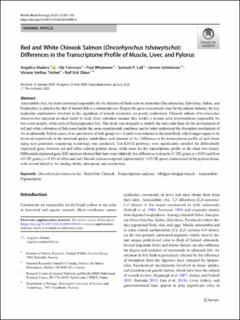| dc.contributor.author | Madaro, Angelico | |
| dc.contributor.author | Torrissen, Ole | |
| dc.contributor.author | Whatmore, Paul | |
| dc.contributor.author | Lall, Santosh P. | |
| dc.contributor.author | Schmeisser, Jerome | |
| dc.contributor.author | Verlhac Trichet, Viviane | |
| dc.contributor.author | Olsen, Rolf Erik | |
| dc.date.accessioned | 2020-09-25T11:02:42Z | |
| dc.date.available | 2020-09-25T11:02:42Z | |
| dc.date.created | 2020-08-02T13:04:18Z | |
| dc.date.issued | 2020 | |
| dc.identifier.citation | Marine Biotechnology. 2020, 22 (4), 581-593. | en_US |
| dc.identifier.issn | 1436-2228 | |
| dc.identifier.uri | https://hdl.handle.net/11250/2679687 | |
| dc.description.abstract | Astaxanthin (Ax), the main carotenoid responsible for the distinct red flesh color in salmonids (Oncorhynchus, Salvelinus, Salmo, and Parahucho), is added to the diet of farmed fish at a substantial cost. Despite the great economical value for the salmon industry, the key molecular mechanisms involved in the regulation of muscle coloration are poorly understood. Chinook salmon (Oncorhynchus tshawytscha) represent an ideal model to study flesh coloration because they exhibit a distinct color polymorphism responsible for two color morphs, white and red flesh pigmented fish. This study was designed to identify the molecular basis for the development of red and white coloration of fish reared under the same experimental conditions and to better understand the absorption mechanism of Ax in salmonids. Pyloric caeca, liver, and muscle of both groups (n = 6 each) were selected as the most likely critical target organs to be involved respectively in the intestinal uptake, metabolism, and retention of Ax. Difference in the transcriptome profile of each tissue using next-generation sequencing technology was conducted. Ten KEGG pathways were significantly enriched for differentially expressed genes between red and white salmon pylorus tissue, while none for the transcriptome profile in the other two tissues. Differential expressed gene (DE) analyses showed that there were relatively few differences in muscle (31 DE genes, p < 0.05) and liver (43 DE genes, p < 0.05) of white and red Chinook salmon compared approximately 1125 DE genes characterized in the pylorus tissue, with several linked to Ax binding ability, absorption, and metabolism. | en_US |
| dc.language.iso | eng | en_US |
| dc.publisher | Springer Verlag | en_US |
| dc.rights | Navngivelse 4.0 Internasjonal | * |
| dc.rights.uri | http://creativecommons.org/licenses/by/4.0/deed.no | * |
| dc.title | Red and white chinook salmon (Oncorhynchus tshawytscha): Differences in the transcriptome profile of muscle, liver, and pylorus | en_US |
| dc.type | Journal article | en_US |
| dc.type | Peer reviewed | en_US |
| dc.description.version | publishedVersion | en_US |
| dc.source.pagenumber | 581-593 | en_US |
| dc.source.volume | 22 | en_US |
| dc.source.journal | Marine Biotechnology | en_US |
| dc.source.issue | 4 | en_US |
| dc.identifier.doi | 10.1007/s10126-020-09980-5 | |
| dc.identifier.cristin | 1821208 | |
| dc.description.localcode | Open Access This article is licensed under a Creative Commons Attribution 4.0 International License, which permits use, sharing, adaptation, distribution and reproduction in any medium or format, as long as you give appropriate credit to the original author(s) and the source, provide a link to the Creative Commons licence, and indicate if changes were made. The images or other third party material in this article are included in the article's Creative Commons licence, unless indicated otherwise in a credit line to the material. If material is not included in the article's Creative Commons licence and your intended use is not permitted by statutory regulation or exceeds the permitted use, you will need to obtain permission directly from the copyright holder. To view a copy of this licence, visit http://creativecommons.org/licenses/by/4.0/. | en_US |
| cristin.ispublished | true | |
| cristin.fulltext | original | |
| cristin.qualitycode | 1 | |

